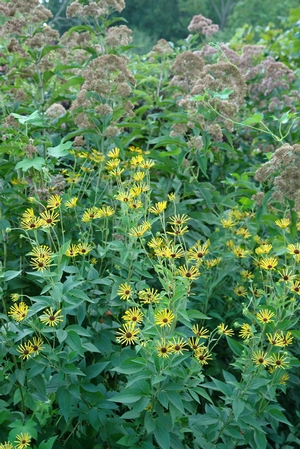





Plant Calculator
Enter the approximate length and width of the area you will be planting and click 'Calculate' to determine how many Rudbeckia subtomentosa 'Henry Eilers' you will need.
Correct and successful spacing is complex and depends on project conditions. We encourage you to call us at 877-ECO-PLUG for project specific recommendations and further assistance.
Rudbeckia subtomentosa 'Henry Eilers'
sweet coneflower (sweet black-eyed Susan)
- Category: Perennial
- Hardiness Zone: 5-7
- Height: 4-5 Feet
- Spread: 2-3 Feet
- Spacing: 18-24 Inches
- Bloom Color: Yellow
Our friend Larry Lowman of Ridgecrest Nursery in Wynne, Arkansas graciously gave us this marvelous plant. It was collected from a railroad prairie remnant in southern Illinois and named for the man who found it, Henry Eilers, a horticulturist and past nurseryman. Basal leaves appear in early spring and flowering stalks begin their ascent in June, reaching five to six feet and full flower by August, often staying in bloom into September. 'Henry Eilers' has finely quilled flowers of true yellow, not gold, and is stunning in a mass planting. It has captivated many visitors who have seen it here and motivated them to ask us to grow it. The leaves of Rudbeckia subtomentosa are sweetly scented with a subtle vanilla fragrance. It is lovely with Joe-Pyes and grasses, and it blooms with the Hibiscus hybrids and makes a great companion for them as well. 'Henry Eilers' has undeniable potential as a cut flower with its unique appearance, sturdy straight stems and long vase life.
Wetland Indicator Status
| • | Falcutative (FAC) |
Plug Type
| • | Landscape Plug™ |
Propagation Type
| • | Vegetative |
Additional Information about Rudbeckia subtomentosa 'Henry Eilers'
"In this region, in many counties, the only remnant of any virgin, unplowed prairie that remains is along railroad tracks. When the railroads were originally built in the 1800's, if they were going over a natural prairie, all they had to do was lay down the wooden crossties, pack in bed fill, and lay the rails... the remaining right-of-way remained essentially undisturbed. In many locales, a road also was constructed parallel to new tracks, so that the few hundred feet of railroad right-of-way trapped between the tracks and the road remained unplowed to this day, and in many areas has reserved a remarkable diversity of prairie species. In most areas, accidental fires happen fairly regularly, which enhances the vigor of the prairie vegetation."-From Prairie Remnants by Larry Lowman
"Larry Lowman, an east Arkansas native plant guru, is such an individual who has introduced a number of plants into the garden trade, including the quilled sweet coneflower.
The quilled sweet coneflower is a selection of Rudbeckia subtomentosa given the cultivar name of 'Henry Eilers', after the nurseryman and prairie restoration specialist who discovered it alongside a streambank in southern Montgomery County, Ill. It was Lowman's ninth plant introduction, being offered for Internet sales by Plants Delight Nursery since 2003.
Though a relative of the more common black-eyed Susan, this perennial grows four to 5 feet tall and is topped with 2-inch wide pinwheel flowers with a brown center and 15 to 20 sulfur yellow ray florets. Unlike the typical ray flowers that splay out flat, in 'Henry Eilers' florets are rolled lengthwise into a quill shape. It blooms in late summer, peaking in mid-August.
It's an upright grower with leaves on the lower part of the plant divided into three segments. Foliage exposed to slight drought stress gives off a faint vanilla scent, the reason for the common name. The species ranges from Wisconsin to Louisiana and is usually found in low, open meadows, in the half shade near streamsides and along roadways.
...Quilled sweet coneflower should be given a sunny location at the back of the border. It's compatible with other perennials in the sunny border, but over feeding, keeping it too wet or over crowding may cause it to topple over on its neighbors.
It has good drought tolerance and survived the horrific 2005 east Arkansas drought without difficulty. According to Larry, only about 15 or 20 percent of the seedlings retain the quilled character, so propagation should be from springtime division." - Excerpted from an article by Gerald Klingaman, retired Extension Horticulturist, University of Arkansas Cooperative Extension
Growing & Maintenance Tips for Rudbeckia subtomentosa 'Henry Eilers'
A vigorous but very manageable perennial that favors average to moist soils and full sun to part shade. It is quite tolerant of heat and humidity, but will not withstand long periods of drought.
